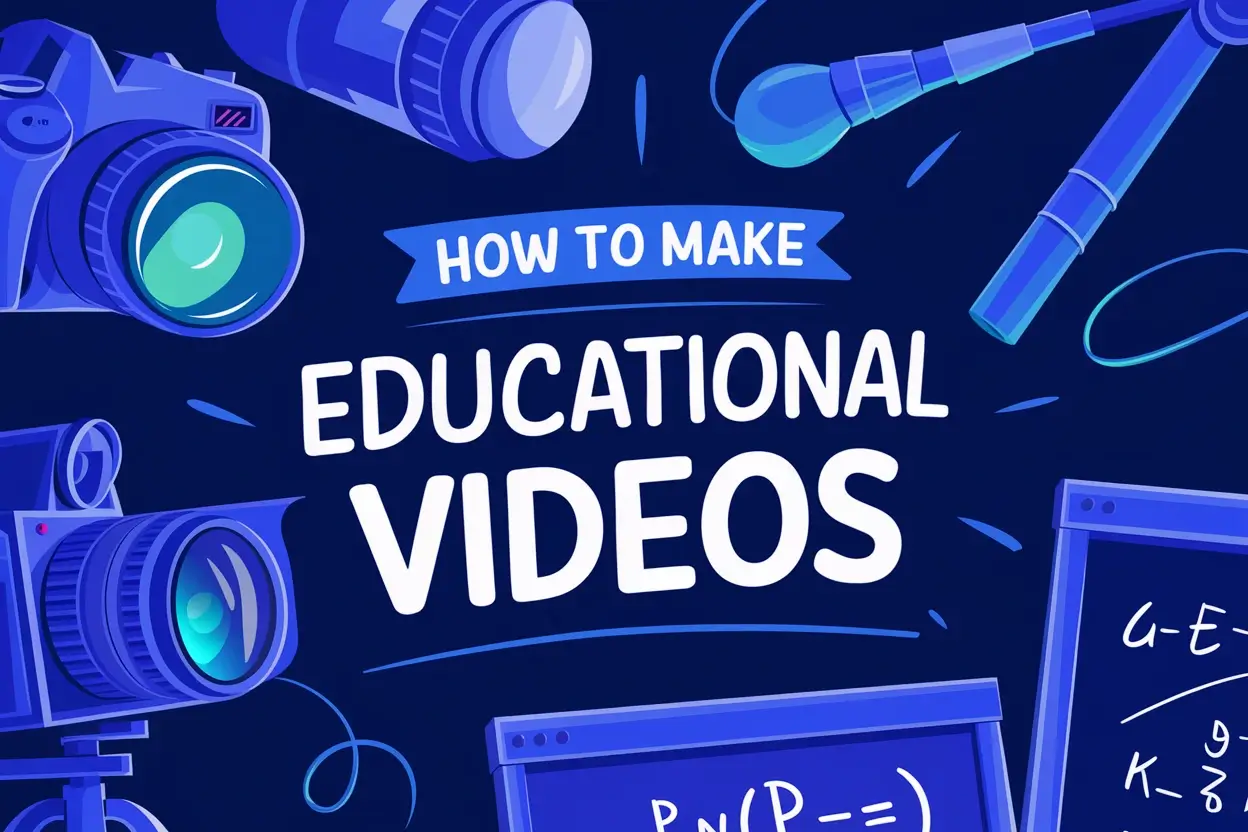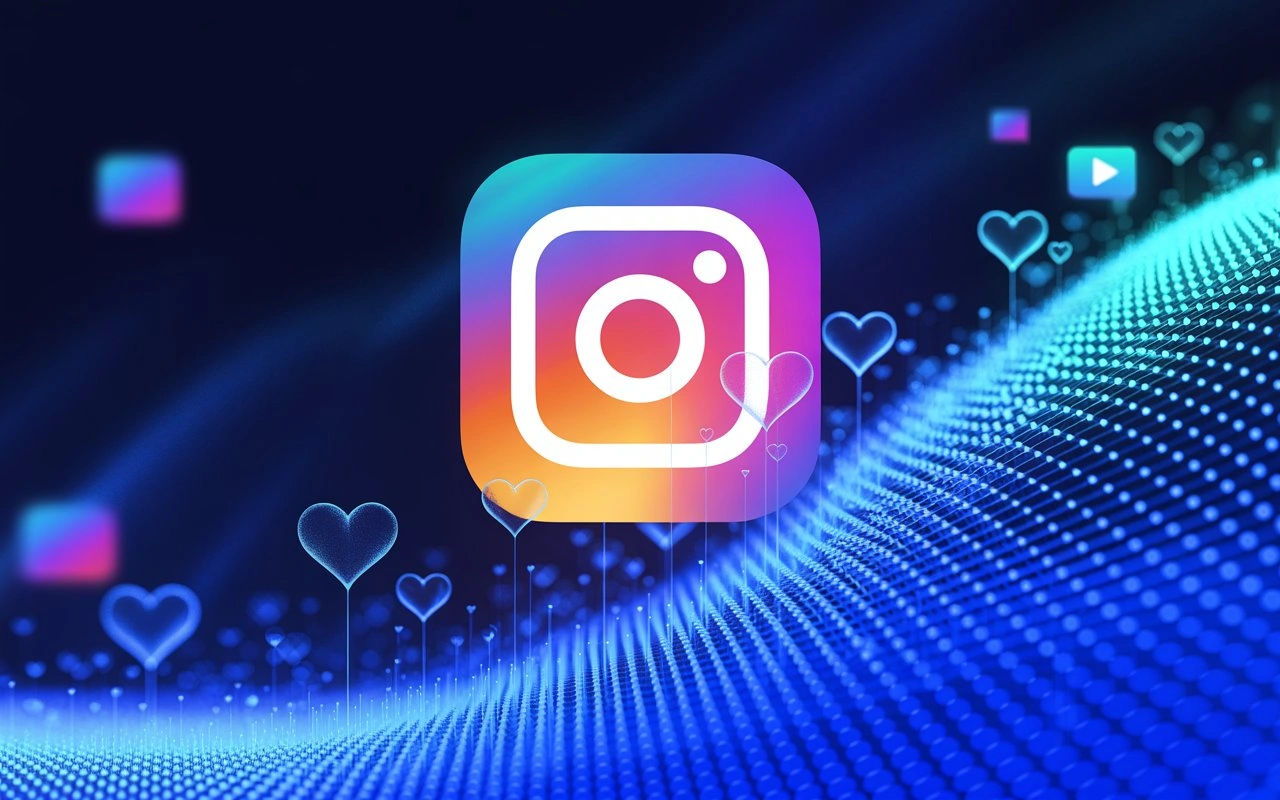Table Of Content
Educational videos teach people about specific topics in a simple, easy-to-understand way. The purpose of these videos is to teach, inspire, and make tricky topics less intimidating by using visuals, sounds, and sometimes animations.
In fact, studies show that viewers retain 95% of a message when they watch it in a video, compared to just 10% when reading text.
Businesses use educational videos to show they are experts in their field and to help customers and employees understand products, services, or concepts.
With 68% of people preferring to learn about a product through video, this format also builds trust, as audiences feel supported by brands that educate.
Once produced, these videos can be reused across platforms without incurring additional costs, thus expanding business reach and deepening audience engagement.
Below I have shared different types of educational videos that you must be aware of before kickstarting your first project.
Types of Educational Videos

Here’s a look at different types of educational videos that really connect with viewers, each made to fit various learning styles and goals.
1. Tutorials and How-To Guides
Tutorials or how-to videos are straightforward. They’re practical, concise, and offer step-by-step guidance on how to accomplish a specific task or skill.
If you’re looking for how to video ideas, think along the lines of "How to Bake the Perfect Loaf of Sourdough" or "How to Set Up Your First Website." From my own experience, these videos are an absolute hit on YouTube.
In fact, with video consumption trends growing, 68% of customers prefer watching a video to help them solve any issues they encounter with your products.
Think about it—who really wants to wade through a 20-page instruction guide when they can watch a 5-minute video? Take a look at how WikiHow uses a tutorial to show how to tie a tie.
2. Animated Explainer Videos
Animated explainers are all about making tough concepts digestible. Using animation, creators can visualize processes that would be hard to capture with real footage.
Imagine trying to explain cellular biology or the blockchain without visuals. Animations make it possible to see these ideas unfold which is why so many creators choose to make an explainer video for difficult topics.
For instance, Two Minute Classroom uses animated video brilliantly to explain a cellular biological concept.
Additionally, a study from Wyzowl in 2024 showed that 91% of marketers said explainer videos helped increase user understanding of their product thus highlighting their effectiveness in communication.
3. Whiteboard Animation Videos
Whiteboard videos are known for making even the most complex processes feel like a friendly brainstorming session.
With a mix of live drawings, voice-overs, and doodles, they are both instructional and interactive and perfect for step-by-step breakdowns—explaining scientific processes, mathematical formulas, or even project management workflows.
However, when creating a whiteboard video, don’t aim for perfection. Small imperfections, like “scribbled” notes or real-time drawings, make the video feel alive and relatable, like a friend explaining something on the spot.
A great example of a whiteboard video is this Practical Psychology video. It educates about the 7 Habits of Highly Effective People by Stefen Covey through visual and narrative. .
4. Documentary-Style Educational Films
Documentary-style educational films explore topics in greater depth. Think: the “Inside Look” series on YouTube, or National Geographic documentaries. These videos aren’t quick or easy to make, but they have the potential to go viral and drive significant engagement if done right.
Moreover, documentary-style videos need a strong narrative arc, real characters, and relatable themes to bring facts to life. People remember such stories much better than raw data.
An example of a powerful documentary-style educational film is Our Planet by Netflix. It uses specific locations and the animals and people affected to show climate change’s impact on ecosystems and communities.
5. Interactive Videos with Quizzes and Exercises
Interactive videos turn passive viewers into active participants with quizzes, prompts, and exercises throughout the video.
Not to mention here, the “Introduction to Python" course by Codecademy integrates quizzes and exercises in the lectures to actively engage learners.
Moreover, this format is ideal for learning-based content—imagine watching a history video and, midway, being asked to guess the next event in a timeline.
It keeps the brain actively engaged and reinforces retention and understanding.
Steps to Start Your Own Educational Video Creation
Educational videos can be a powerful way to share knowledge, but the process can feel daunting because you need to break down complex information without losing key details.
Plus, add in the technical skills and time commitment needed, and it’s easy to see why many feel overwhelmed.
But if you break it down into steps, the process is manageable. So, below I have shared the step-by-step guide on how to make your own educational video without even feeling stressed.
Step 1: Define Your Educational Goal
Before you hit a record, decide what you want your viewers to learn or achieve. Setting clear goals gives your video direction and helps you connect with your audience.
I’ve made the costly mistake of trying to cover too much in a single video. Once, I tried to teach an entire content strategy in one go—it was overwhelming for viewers and the engagement dropped dramatically.
Instead, zero in on one specific skill, like “how to set up a powerful social media calendar.”
Zebracat makes this incredibly easy. By simply entering your educational objective, the AI can help suggest dynamic scenes, structure, and even the perfect voiceover to match your distinctive teaching tone.
Step 2: Plan Your Content Structure
Your content needs a solid flow to keep viewers engaged. Without it, your message can easily become confusing, and viewers lose focus fast.
Imagine you’re guiding someone through a topic. If you jump from one idea to another without a roadmap, it’s like taking them on a detour without a map.
I remember one of my early videos on social media strategy. I packed in tons of information, thinking I was being thorough. But halfway through, my viewers were dropping off.
Why?
I hadn’t given them a clear path. Later on, I learned that a good structure isn’t about adding more information, it means organizing it logically so each point builds on the previous one.
To solve this, I developed a three-part approach that made a difference:
- Start by hooking up with a relatable problem or question. It immediately tells viewers they’re in the right place.
- Break down the content into logical steps that flow naturally, like a story with a beginning, middle, and end. If I’m explaining a strategy, each point becomes a “chapter” that builds on the last.
- End with a quick recap of key points and a call to action, which leaves viewers with a sense of completion and purpose.
Moreover, in 2024, AI tools have made this process as easy as pie.
With Zebracat's text-to-video tool, you can skip the manual structuring.
Just input a rough script or even a blog post, and it organizes the content into a logical flow, adding transitions and highlights to emphasize key points.
This saves you time and gives a polished, professional video without the need for extensive editing skills.
Step 3: Choose the Right Equipment
You don’t need fancy equipment to start. I’ve made high-engagement videos with just my phone and a basic mic.
There was a time when I spent over $1,000 on equipment I barely used because I thought it would make my content look “professional.”
Looking back, some of my best content was shot with minimal gear. It’s really about how you use what you have.
And now with Zebracat, you can even create videos with minimal or no equipment at all. Zebracat can fill the quality gap with its AI editing. It saves your time and money and optimizes your viewer retention rates by up to 50%.
Step 4: Record the Video
Recording can feel intimidating at first. When I started, I’d ramble or get nervous, resulting in tons of retakes. Then I found that recording in small, manageable sections helped.
Break your script down into “mini-scenes” and take pauses to regroup between them. I will keep you from feeling overwhelmed and make editing easier.
If you’re camera-shy, Zebracat allows you to skip the recording altogether.
Just use the text-to-video feature to create a professional-looking video from your script, complete with AI voiceovers.
Here’s how you can use the text-to-video feature of Zebracat:
- Select your visual style from 6 different available styles or create your custom ones.

- Enter your prompt and Zebracat turns it into a ready-to-go script.

- Toggle on "Character Consistency" to ensure that the character traits and behaviour remain stable throughout the video

- Select the video ratio and length.


- Now choose video language and voice. You can also clone your own voice.


- After that, select video mode from 7 different moods available like Happy, Serious, Epic etc. Then click “Next Step”

- Pick one AI generated script and click on “Generate Video.”
- Zebracat will give you the video with added visuals, voiceovers, and effects in just a few minutes.
- Preview, adjust if needed, and then download or share.
Step 5: Edit Your Video
Editing can be the most time-consuming part of the process. I used to spend days trying to get every frame perfect.
Once, I even spent over 12 hours editing a single 5-minute video. Then I realized viewers cared more about the message than tiny editing details.
Pro Tip 💡
With Zebracat video editing, you can add effects, transitions, and sound effortlessly 10x faster.
Simply:
- Click on the "Media" icon on the left to import photos, videos, or other visual elements you want to include.

- Use the "Voice" option to change the voiceover.

- Click on the "Text" icon to edit your video text. Here you have the options to add text effects or edit font, size, font weight, text alignment, shadow, and background color.

- Use the "Music" icon to choose background music that fits the mood of your content.

- Tap on "Animation" to apply motion effects to visuals or text, making them more dynamic.

- Use the "Transition" icon to add smooth changes between clips or scenes for a seamless video flow.

- Click on "Elements" to add emojis and GIFs that enhance the video visually.

- You can also use the timeline at the bottom to adjust the length and timing of each element. Play the video preview to check your edits and ensure the flow is smooth.
.webp)
- Once you’re satisfied with the final edit, click the "Export" button at the top right to download or share your video.
Step 6: Optimize for Engagement
Holding a viewer's attention in a video requires more than just presenting facts. You have to create a connection that keeps them watching.
Early on, I noticed that simply delivering information often led to drop-offs before the video’s key points.
So use visuals, emphasize key points, and keep the pace steady. Adding a CTA halfway through can also keep viewers interested. In fact, 93% of marketers said that interactive videos are highly effective for educating customers.
With said, you can also add teasers throughout the video, like, “Stay tuned for the bonus that will simplify this process.” All these gave people a reason to keep watching.
Step 7: Publish the Video
Publishing isn’t as simple as hitting “upload.” I once uploaded a video without optimizing the title or description—it barely got any views.
Now, I take time to create a title and description with keywords that my audience would search for, and it’s made a world of difference.
For example, if you're publishing a tutorial on digital marketing, terms like "digital marketing basics," "how to start in digital marketing," or "marketing tips for beginners" could be valuable additions.
Moreover, consider posting at times when your audience is active. A/B tests different platforms and times to see where engagement peaks.
Step 8: Promote Your Video
The first time I published a video, I thought that was the end of it. But promoting your video is half the work. Share your video on social media, in relevant groups, and with your email list. Collaborate with other creators for extra reach.
Another tip is to double down on your most effective traffic sources. Review your YouTube Analytics to identify where your views are coming from, whether that’s search, suggested videos, or external links. If YouTube Search is performing well, continue optimizing for SEO. If suggested videos are driving traffic, prioritize creating content similar to popular videos in your niche.
I have found that sharing your videos on forums and Q&A sites like Reddit or Quora can be powerful if done thoughtfully. Instead of just dropping a link, create a post explaining what the video offers and engage with the community by answering questions and participating in discussions.
For example, if you made a video about the Paleo diet, find subreddits or Quora threads where people are discussing it, and offer your video as a resource.
Step 9: Analyse and Improve
After publishing, look at the metrics. Key metrics to watch include viewer retention, which shows how long people stay engaged, and drop-off points, which reveal where interest declines.
If viewers are leaving at a particular time, it may indicate a need to restructure or streamline content in that section.
When I started regularly analyzing my videos, I discovered that shorter videos performed better for my audience, leading me to adjust my content strategy.
In addition, CTR on titles and thumbnails is also crucial, as it shows how appealing your video is compared to others.
A low CTR could mean your title or thumbnail isn’t compelling enough, while a high CTR with low retention might suggest that the content doesn’t match viewer expectations.
Using analytics, you can also identify repeat viewers and subscriber growth, which shows if your content is building a loyal audience.
Consider these key performance metrics when evaluating your educational videos:
Adjusting based on these insights can significantly improve your content’s effectiveness and keep your audience coming back for more.
Secret Tips for Creating Effective Educational Videos
Creating educational videos that actually teach, engage, and stick with viewers takes more than just sharing information.
After years of building AI videos for YouTube and TikTok channels, I’ve picked up a few tricks (some hard-won) that help make educational content effective and memorable.
Maintaining a Regular Publishing Schedule
Consistency is everything. Early in my YouTube journey, I posted sporadically and saw inconsistent engagement.
But as soon as I committed to a regular schedule, my views started climbing steadily. Audiences love predictability. It builds trust and anticipation.
Pro Tip 💡
- Find a rhythm that you can sustain long-term. Whether it’s weekly or monthly, stick to it.
- If weekly feels too much, start bi-weekly and adjust. Consistency will keep your audience coming back, convert casual viewers into regulars.
Stay Updated with Trends
Educational content doesn’t exist in a vacuum—audience interests shift, sometimes fast. When TikTok started taking off, I resisted at first, sticking with YouTube.
But as TikTok exploded, so did short-form educational content. So make your habit to check trending topics weekly on Google Trends, Reddit, YouTube trending, and even TikTok.
If you can tie your content into a current trend or popular topic, you’re more likely to attract a fresh audience.
Keep Videos Short and Focused
Attention spans are getting shorter, especially online. Research even backs this up: Average human attention span dropped from 12 seconds to 8 seconds.

I used to pack videos with as much info as possible, thinking I was adding value. Instead, viewers dropped off midway.
Through trial and error, I found that my audience preferred videos under 5 minutes. If the topic requires more depth, consider splitting it into parts.
Quick Tip ⚡️
- Just cover one main idea per video. A clear, focused video often outperforms long-winded explanations.
Segment Content Into Manageable Parts
Breaking down content into sections or mini-chapters works wonders for retention. Imagine trying to learn a complex marketing strategy in one long block—overwhelming, right?
Now, I use timestamps, titles, or visual dividers to make information easier to digest.
Data revealed that videos with timestamps tend to rank better in search results on both YouTube and Google.
Each click on a timestamp is counted as an additional view, which can further boost the video's visibility.
Moreover, adding chapters lets viewers skip to the parts they care about most, and they’re more likely to watch the whole video because it feels organized and accessible.
Integrate Quizzes or Interactive Elements
Interactive elements like quizzes or prompts make a passive experience active.
I tested adding simple questions midway, like, “What would you do in this situation?” It helped people stay tuned and think deeper about the topic. Engagement went up by 25% in videos where I included these interactive bits.
Also, if quizzes feel too formal, try posing thought-provoking questions.
For instance, in a marketing tutorial, you might ask, “How would you improve this ad?” It adds an engaging touch without needing extra tech, and it keeps viewers engaged longer.
Provide Real-World Examples
Theoretical knowledge is useful, but viewers need to see how it applies in the real world. For instance, when I’m explaining marketing funnels, I don’t just list steps. I show a case study of how a small business successfully implemented the funnel and increased sales.
Real examples make concepts concrete, showing viewers exactly how they can apply the information themselves.
The Bottom Line
Educational videos are one of the most powerful ways to connect with audiences today. They can teach intimidating topics and even change how viewers approach challenges in their lives or careers.
When done well, they’re resources that viewers return to, share with friends, and remember long after watching.
But here’s the thing: creating high-quality videos doesn’t have to be overwhelming.
Zebracat simplifies the technical side—turning your ideas, blogs, or scripts into polished face and faceless YouTube videos with AI-generated voiceovers, animations, and custom visuals.
That way, you can focus on what you do best: teaching, inspiring, and connecting with your audience. So, why not get started today? Your ideas deserve to be shared, and Zebracat can help you bring them to life with ease.
Create videos 10x faster and easier with Zebracat
Try it now









Comments